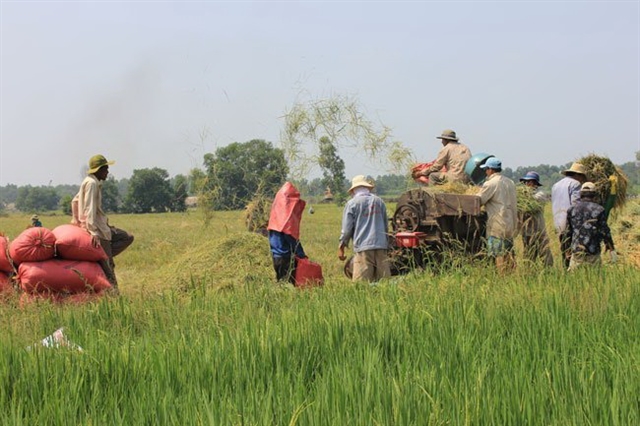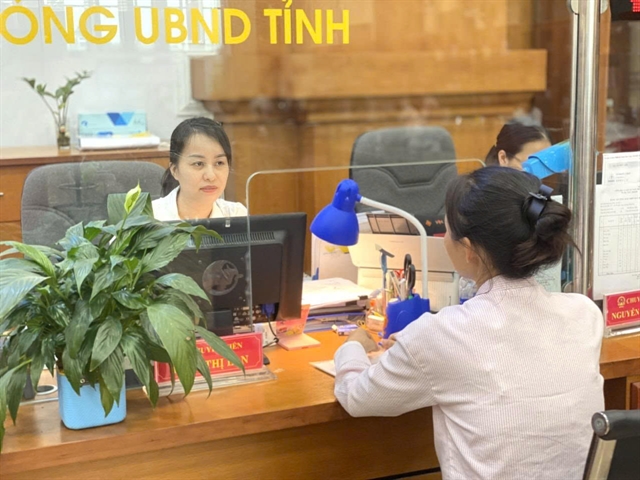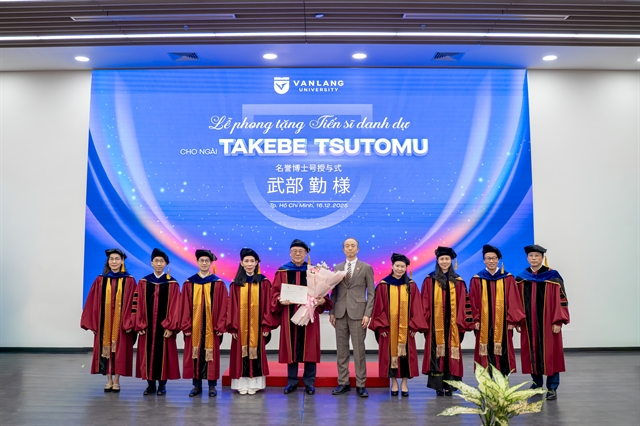 Economy
Economy


|
| Farmers harvesting rice in the Mekong Delta. Photo english.vietnamnet.vn |
HCM CITY — With an abundant global supply and high inventory in major exporting countries, Việt Nam is expected to struggle to secure exports of rice in the second half of the year, speakers said at a conference held in HCM City on Monday.
Trần Quốc Khánh, deputy minister of Industry and Trade, said that Việt Nam’s rice exports in the first half of the year experienced great challenges due to a drop in demand from major importers.
Except for the Philippines, the country’s three major traditional rice importing countries such as China, Indonesia and Bangladesh all imported much less in the first half of the year.

|
| Speakers at a conference held yesterday in HCM City discuss the status of Viet Nam's rice exports in the first half of the year. VNS Photo Bồ Xuân Hiệp |
The trend is expected to continue for the rest of the year because of the high inventory in China, an election year in Indonesia, and Bangladesh’s ongoing recovery from flooding, Khánh said.
The decline in imports from these markets has also affected two other leading rice exporters, India and Thailand.
In the first five months, Việt Nam exported a combined 239,000 tonnes of rice to China, Indonesia and Bangladesh, compared with 1.44 million tonnes over the same period last year, according to the Export and Import Department under the Ministry of Industry and Trade.
In recent years, many rice importing countries have imposed rice tariffs and allowed other rice suppliers to participate in the G2P (government-to-private) tenders in order to buy rice of higher quality at more competitive prices.
Meanwhile, countries such as Myanmar, Cambodia, and Pakistan are trying to increase their rice export output.
In addition, China is not only the largest rice importer, but also one of the world’s major rice exporters.
Solutions
The Ministry of Industry and Trade is working with agencies such as Việt Nam Food Association and rice exporters to implement solutions, such as reviewing policies of foreign markets, according to Deputy Minister Khánh.
While negotiating bilateral and multilateral free trade agreements, the ministry has discussed with foreign partners about tax reductions and removal of trade and technical barriers for Vietnamese rice products.
The ministry has also updated information for local enterprises and associations about regulations on food hygiene and safety, quality control and traceability.
Many programmes on trade promotion and brand development have been luanched, including trade fairs in mainland China, the Philippines, Indonesia, Malaysia, Singapore and Hong Kong, as well as France, the Netherlands, Ghana, Ivory Coast and the US.
To assist businesses in studying customer demand and promoting exports, the ministry has worked with localities that produce high outputs of rice, such as An Giang, Long An, and Kiên Giang provinces, Cần Thơ City, and HCM City.
Experts have recommended that Vietnamese exporters diversify export and import markets and avoid dependence on only certain markets.
New decree
Taking effect in October last year, Decree 107/2018/ND-CP, which replaced an older decree, aims to remove legal barriers for rice businesses to expand to foreign markets.
According to the new decree, rice-exporting businesses will no longer be required to own rice storage or paddy milling and grinding facilities with processing capacities of 5,000 tonnes of rice and 10 tonnes of paddy per hour, respectively.
Instead, they now can rent such facilities from other agencies and organisations. The capacity volume requirements have also been removed.
Trần Văn Công, deputy director of the Ministry of Agriculture and Rural Development’s Agro Processing and Market Development Authority, said the new decree would help rice traders cut costs significantly.
Khánh said the decree was a breakthrough in institutional policy regarding rice export activities, removing difficulties for rice firms.
The decree also stipulates additional regulations on the responsibilities of ministries, sectors and localities in rice export management.
According to the General Department of Customs, Việt Nam’s rice exports reached 2.76 million tonnes in the first five months, down 6.3 per cent compared to the same period last year. The country earned US$1.18 billion worth of exports in the period, a decline of 20.4 per cent over the same period last year.
The country’s rice products are exported to 150 countries and territories, including the Philippines, Malaysia, Indonesia, mainland China, Cuba, Hong Kong, Singapore, Iraq, Ivory Coast, Ghana and Mozambique. — VNS




